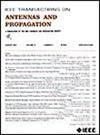Midrange Radiative Wireless Power Transfer Based on the Improved Half-Fisheye Lens
IF 5.8
1区 计算机科学
Q1 ENGINEERING, ELECTRICAL & ELECTRONIC
引用次数: 0
Abstract
An improved half-fisheye lens (HFL) is proposed to achieve efficient midrange radiative wireless power transfer (RWPT). First, the study analyzes the factors that impede the attainment of optimal power transfer efficiency (PTE) in a mirror-symmetric RWPT system composed of a pair of conventional HFLs under practical feeding conditions. Subsequently, the field distribution conditions requisite for achieving optimal PTE in the HFL-based RWPT system are derived. Guided by these conditions, a mirror-symmetric RWPT system comprising a pair of improved HFLs is designed to achieve optimal PTE under practical feeding conditions. The improved HFL consists of a redesigned HFL and a transition layer. The transition layer not only mitigates the impedance mismatch at the interface but also achieves a time-reversal symmetric field distribution required for optimal PTE. The redesigned HFL undergoes axial compression and refractive index distribution modification, thereby reducing the lens’s refractive index while maintaining its profile height. Finally, to validate the effectiveness of the proposed design, a midrange RWPT prototype based on the improved HFL is designed and fabricated. The experimental results show that the RWPT system based on the improved HFL can achieve a PTE of 41% at a transfer distance of基于改进半鱼眼镜头的中程辐射无线传输
提出了一种改进的半鱼眼镜头(HFL),以实现高效的中距离辐射无线功率传输(RWPT)。首先,分析了在实际进料条件下,由一对传统HFLs组成的镜像对称RWPT系统实现最优功率传输效率(PTE)的影响因素。在此基础上,推导了基于高通量的RWPT系统实现最佳PTE所需的现场分布条件。在这些条件的指导下,设计了一个由一对改进的HFLs组成的镜像对称RWPT系统,以实现实际进料条件下的最佳PTE。改进的HFL由重新设计的HFL和一个过渡层组成。过渡层不仅减轻了界面处的阻抗失配,而且实现了最佳PTE所需的时间反转对称场分布。重新设计的HFL经过轴向压缩和折射率分布修改,从而在保持其轮廓高度的同时降低了透镜的折射率。最后,为了验证所提设计的有效性,设计并制造了基于改进HFL的中程RWPT原型机。实验结果表明,当采用喇叭天线馈电时,基于改进HFL的RWPT系统在传输距离为$d=8\lambda $时的PTE可达41%,与基于传统HFL的RWPT系统相比,PTE提高了70%。
本文章由计算机程序翻译,如有差异,请以英文原文为准。
求助全文
约1分钟内获得全文
求助全文
来源期刊
CiteScore
10.40
自引率
28.10%
发文量
968
审稿时长
4.7 months
期刊介绍:
IEEE Transactions on Antennas and Propagation includes theoretical and experimental advances in antennas, including design and development, and in the propagation of electromagnetic waves, including scattering, diffraction, and interaction with continuous media; and applications pertaining to antennas and propagation, such as remote sensing, applied optics, and millimeter and submillimeter wave techniques

 求助内容:
求助内容: 应助结果提醒方式:
应助结果提醒方式:


